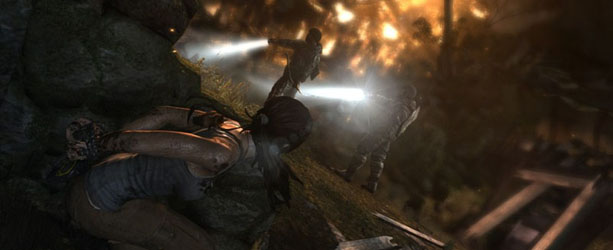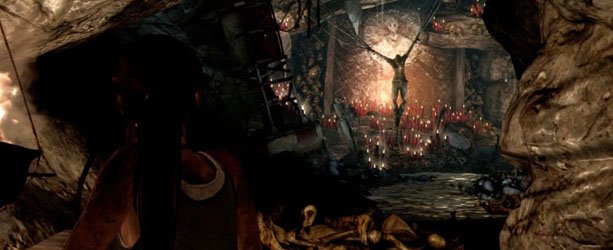
Tomb Raider Review
Platforms: PC, PS3, Xbox 360Publisher: Square Enix
UK Price (as reviewed): £29.99 (inc VAT)
It’s fitting that thematically this new Tomb Raider is about adapting, changing and ultimately surviving. It’s as true of Lara Croft’s journey as it is of this game’s attempt to make the series relevant again and fit within modern expectations.
Tomb Raider is a legacy game, one that produced a massive impact at the time, remains an important franchise and made the protagonist an icon. For all its importance, the way that other games handle the core concepts of shooting and climbing has progressed since the series was at it’s most notable. Adventures based on what Tomb Raider began have entirely changed how we think about it’s systems. We use weapons in different ways now, emphasising defense through finding cover as much as attack, we traverse environments completely differently, not needing as complex a set of rules about different methods of jumping.
This game is the result of recognising where design currently resides. This doesn’t feel much at all like the previous entries and that’s entirely a move for the better. This feels much like the sum of other parts. Learning lessons of effectiveness from other sources in recent memory and distilling down what made them successful.
Lara’s arsenal of weaponry is limited to five things and their alternate attacks. There’s no swan diving. There’s a variety of different upgrade mechanics that grow her abilities as well as the effectiveness of her gear. You can fast travel. You can backtrack and use newly discovered equipment in old areas. There are collectables. There are hidden areas with optional puzzles. There’s a vision mode that shows you the direction you should be heading toward. Some enemies carry riot shields and some are heavily armoured. This is a game that has learned lessons based on paying attention and displays that knowledge effectively. Every step it takes toward modernisation is the correct one.
That’s not to say that it eshews everything that makes Tomb Raider what it was. There’s still environmental puzzles that have to be solved by understanding the objects in your environment, piecing them together, turning things on at the right time and jumping over to somewhere else before everything resets. Some of these puzzles actually provided significant challenge, though that was a fault of not paying enough attention to all of the signposted possibilities.
It’s not just mechanically a more interesting experience. Narratively it offers so much more. The journey of Lara Croft is one that, although eventually becoming somewhat overblown for the purposes of providing a video game, has some necessary realism at the outset. She spends an hour being brutally ill-prepared for life on the island that she’s crash landed on. She’s hurt repeatedly, but from that hurt there’s growth, there’s the gradual unravelling and revealing confidence hidden behind layers of self doubt. She earns the ability to be seen as the character she’s always been.
That overblown nature does eventually feel at odds with the personal story at the heart of the game. She begins as someone distraught over the idea of taking a life, but proceeds to take hundreds more within the course of the game. This is an issue with a game needing to provide violence as an activity, but by no means is this a suggestion that the plot should have been altered to limit the amount of dissonance. The game makes violence fun and provides it, the game also provides a worthwhile story. The two things conflict, but not in a way that can’t mentally be overcome.

MSI MPG Velox 100R Chassis Review
October 14 2021 | 15:04












Want to comment? Please log in.